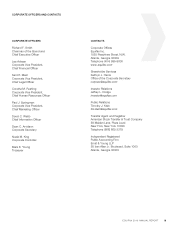Equifax 2010 Annual Report Download - page 21
Download and view the complete annual report
Please find page 21 of the 2010 Equifax annual report below. You can navigate through the pages in the report by either clicking on the pages listed below, or by using the keyword search tool below to find specific information within the annual report.
International Operating Margin. Operating margin decreased for
2010, as compared to 2009, primarily due to a shift in product mix
and increased operating expenses. Operating expenses increased
8% for 2010, in local currency, when compared to 2009, due to
increased revenue and expense investments in new product develop-
ment and increased sales force, particularly in Brazil. Operating
margin decreased for 2009, as compared to 2008, due to the
revenue declines discussed above. Operating expenses decreased
1% for 2009, in local currency, when compared to 2008, compared
to a 4% decline in revenue in local currency.
TALX
TALX Twelve Months Ended December 31, Change
2010 vs. 2009 2009 vs. 2008
(Dollars in millions) 2010 2009 2008 $ % $ %
Operating Revenue:
The Work Number $209.1 $158.2 $131.9 $50.9 32% $26.3 20%
Tax and Talent Management 186.5 188.2 173.2 (1.7) -1% 15.0 9%
Total operating revenue $395.6 $346.4 $305.1 $49.2 14% $41.3 14%
% of consolidated revenue 21% 20% 16%
Total operating income $ 92.1 $ 75.4 $ 53.1 $16.7 22% $22.3 42%
Operating margin 23.3% 21.8% 17.4% 1.5 pts 4.4 pts
The Work Number. Revenue from The Work Number increased
$50.9 million, or 32%, in 2010 compared to 2009 due to mid-double
digit growth from traditional employment based verification and
complementary services, with strong demand across each of the
mortgage, pre-employment screening, social services and collections
sectors; and due to the impact of our acquisition of Rapid Reporting
Verification Company in the fourth quarter of 2009. Revenue
increased in 2009, as compared to 2008, due to the increased
volumes of verifications of consumer employment from government
service agencies, who use our services to approve benefits to
consumers under certain government programs, and verifications of
employment and income by financial institutions, who confirm
consumer data for use in underwriting decisions. Our acquisition of
Rapid Reporting Verification Company in November 2009 provided
approximately $5 million of incremental revenue.
Tax and Talent Management Services. The decrease in revenue
during 2010, as compared to the prior year, resulted primarily from
expected declines in our Tax Management Services business driven
primarily by decreases in unemployment compensation claims activ-
ity, partially offset by revenue growth in our Talent Management
Services business due to increased government hiring activity at the
U.S. Transportation and Security Administration and other large
government customers. The increase in revenue during 2009, as
compared to 2008, resulted from growth in our Tax Management
Services business driven primarily by increased unemployment
compensation claims activity due to the high levels of unemployment
in the U.S., partially offset by declines in volume from our Talent
Management Services business during the first half of the year, as
demand was negatively impacted by reduced hiring activity by
employers, particularly governmental agencies who are key clients,
caused by the weakened economy and budgetary pressures.
TALX Operating Margin. Operating margin increased 150 basis
points for 2010, as compared to 2009, and 440 basis points in 2009,
as compared to 2008, due to continued revenue growth, while
operating expenses grew at a slower rate due to the leveraging of
certain fixed operational and overhead costs and certain operating
process efficiencies for both periods.
EQUIFAX 2010 ANNUAL REPORT 19
19
























